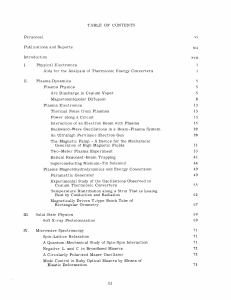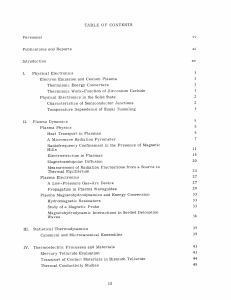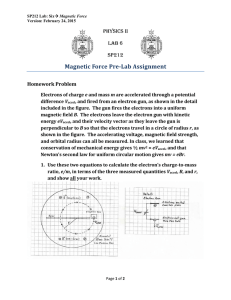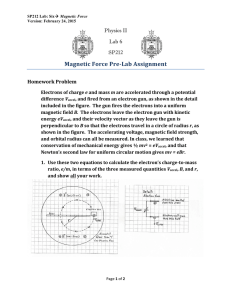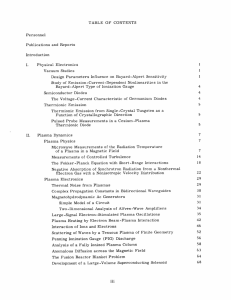MEASUREMENT OF ELECTRON MOBILITY ACCORDING TO THE
advertisement
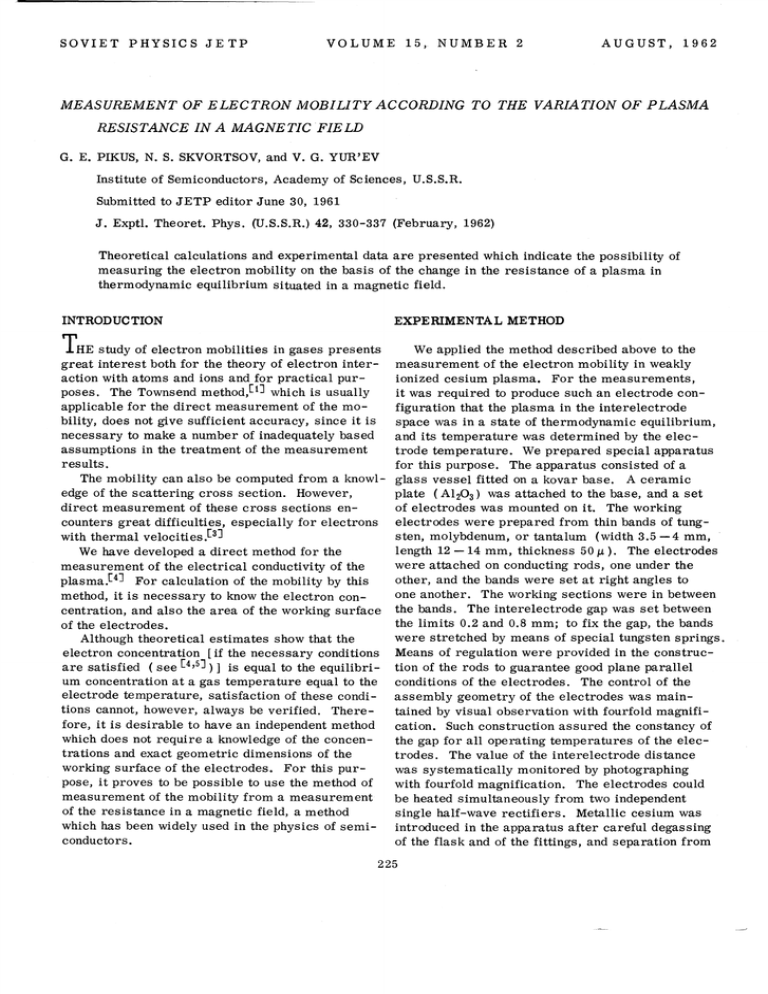
SOVIET PHYSICS JETP
VOLUME 15, NUMBER 2
AUGUST, 1962
MEASUREMENT OF ELECTRON MOBILITY ACCORDING TO THE VARIATION OF PLASMA
RESISTANCE IN A MAGNETIC FIELD
G. E. PIKUS, N. S. SKVORTSOV, and V. G. YUR'EV
Institute of Semiconductors, Academy of Sciences, U.S.S.R.
Submitted to JETP editor June 30, 1961
J. Exptl. Theoret. Phys. (U.S.S.R.) 42, 330-337 (February, 1962)
Theoretical calculations and experimental data are presented which indicate the possibility of
measuring the electron mobility on the basis of the change in the resistance of a plasma in
thermodynamic equilibrium situated in a magnetic field.
INTRODUCTION
THE
EXPERIMENTAL METHOD
study of electron mobilities in gases presents
great interest both for the theory of electron interaction with atoms and ions and for practical purposes. The Townsend method,[!] which is usually
applicable for the direct measurement of the mobility, does not give sufficient accuracy, since it is
necessary to make a number of inadequately based
assumptions in the treatment of the measurement
results.
The mobility can also be computed from a knowledge of the scattering cross section. However,
direct measurement of these cross sections encounters great difficulties, especially for electrons
with thermal velocitiesPJ
We have developed a direct method for the
measurement of the electrical conductivity of the
plasma.C 4J For calculation of the mobility by this
method, it is necessary to know the electron concentration, and also the area of the working surface
of the electrodes.
Although theoretical estimates show that the
electron concentration [if the necessary conditions
are satisfied (see [ 4 •5])] is equal to the equilibrium concentration at a gas temperature equal to the
electrode temperature, satisfaction of these conditions cannot, however, always be verified. Therefore, it is desirable to have an independent method
which does not require a knowledge of the concentrations and exact geometric dimensions of the
working surface of the electrodes. For this purpose, it proves to be possible to use the method of
measurement of the mobility from a measurement
of the resistance in a magnetic field, a method
which has been widely used in the physics of semiconductors.
We applied the method described above to the
measurement of the electron mobility in weakly
ionized cesium plasma. For the measurements,
it was required to produce such an electrode configuration that the plasma in the interelectrode
space was in a state of thermodynamic equilibrium,
and its temperature was determined by the electrode temperature. We prepared special apparatus
for this purpose. The apparatus consisted of a
glass vessel fitted on a kovar base. A ceramic
plate ( Al 20 3 ) was attached to the base, and a set
of electrodes was mounted on it. The working
electrodes were prepared from thin bands of tungsten, molybdenum, or tantalum (width 3.5-4 mm,
length 12 -14 mm, thickness 50 J.l ). The electrodes
were attached on conducting rods, one under the
other, and the bands were set at right angles to
one another. The working sections were in between
the bands. The interelectrode gap was set between
the limits 0.2 and 0.8 mm; to fix the gap, the bands
were stretched by means of special tungsten springs.
Means of regulation were provided in the construction of the rods to guarantee good plane parallel
conditions of the electrodes. The control of the
assembly geometry of the electrodes was maintained by visual observation with fourfold magnification. Such construction assured the constancy of
the gap for all operating temperatures of the electrodes. The value of the interelectrode distance
was systematically monitored by photographing
with fourfold magnification. The electrodes could
be heated simultaneously from two independent
single half-wave rectifiers. Metallic cesium was
introduced in the apparatus after careful degassing
of the flask and of the fittings, and separation from
225
226
PIKUS, SKVORTSOV, and YUR'EV
the vacuum system was carried out at a pressure
of ~ ( 1 - 2) x Io- 7 mm mercury.
A magnetic field perpendicular to the flow of
emitted electrons was produced by placing the
apparatus in a solenoid, after which the location of
the apparatus was rigidly fixed. The dimensions
of the solenoid guaranteed good homogeneity of the
field in a space which appreciably exceeded the
dimensions of the heated electrodes. The magnetic
field at the location of the electrodes was previously
calibrated with a fluxmeter. In the measurements,
the apparatus was placed together with the solenoid
in a thermostatic oven, whose temperature determined the saturated vapor pressure of the cesium
in the apparatus.
The measurement of the resistance in the presence and absence of the magnetic field was carried
out during the non-conducting half-cycle by the
method described by us elsewhere.[ 4] The high
frequency of the supply voltage ( 400 cps) guaranteed the constancy of the electrode temperature
during the cycle, with an accuracy to within 0.5
per cent. The eh~ctrode temperatures was measured by an optical pyrometer. In this case, the
difference in the temperatures of the two electrodes
did not exceed 10 -15° K.
The kinetic equation which determines the distribution function of the electrons f has the form
V
Vf
+ !_
'VqJ'Vvfo- .!..__ [vH] 'Vvf=- f : fo
m
em
•
(I)*
where fo is the equilibrium distribution function in
a system of coordinates moving with the plasma:
fo =
,
e<P.-•'JfkT'
e
= 2m
""l ( ')2
LJ VI '
v' = v- v0 •
i
Here v is the velocity of the electrons in the fixed
system of coordinates, v 0 is the hydrodynamic
velocity of the plasma, J.L is the chemical potential
of the electrons, E = - \lcp is the electric field, H
the magnetic field, and T the relaxation time of
the electrons. The first term in (1) gives a contribution to f of the order of (vT /d) f:::::: lf/d, where
z is the mean free path and d is the interelectrode
distance.
As is shown in [ 7], account of this term leads to
corrections of the order of l/d and for l « d it
can be neglected. Then, putting f in the form
f = f 0 + f 1,
!_(E'+~
[voHl) 'Vvfo
m
c
+ me
.!..__ [vH] 'Vvfi =
~• fh
(2)
which differs from the usual kinetic equation in the
fact that, in place of e · E, we have the quantity
THEORY
With the described geometry of the apparatus,
the condition of the plasma differs from the corresponding conditions in the semiconducting specimens usually employed in the measurement of the
conductivity OJI in the magnetic field. In the first
place, the semiconducting specimens were so prepared that the lengths of the specimens far exceeded
their transverse dimensions. Therefore, in these
specimens, the transverse Hall current is equal to
zero while the resulting Hall voltage must be taken
into consideration in the calculation of <TH·[s] In
our case, the opposite relation holds, since the
distance between the electrodes is much less than
the transverse dimensions of the operating part.
Therefore, the Hall current is shorted by the electrodes and the Hall voltage is practically zero.
In the second place, in contrast with the semiconductor, the plasma can move freely between the
electrodes under the action of ponderomotive forces
which arise in the magnetic field. In the motion of
the plasma, an additional Lorentz force acts on the
electron which, in principle, must be taken into
consideration in the calculation of <TH· For this it
is necessary to find a common solution of the kinetic
equation for electrons in a moving plasma and the
equation of motion of the plasma.
,
eE'
=
eE
+ (e/c)
[voHl.
(3)
We seek f 1 in the form
fl
=
(vx (e)) ato!ae';
(4)
in this case, it is necessary to take it into account
that both x and v 0 are proportional to E. Omitting the terms that are quadratic in E, we get the
usual equation
eE'
+ (elmc)
[HxJ = x!T.
(5)
The solution of this equation has the form
X=
1
7 ) [E' + -r [wE] + -r w (wE)],
+
(J)'t'
2
2
(6)
where
w
= eH/mc.
The resulting current produced by the electrons
(after deduction of the current j 0 = - env 0, which
compensates the corresponding ion current), is
given by the expression
•
J
=
\
/
3
1
vd v =
a{o d
J vx) v ae'
v,
r(
3
(7)
where n is the electron concentration and is equal
*(vH]
=
V X
H
MEASUREMENT OF ELECTRON MOBILITY
~1L<1q
to the ion concentration. Hence the ratio of the
quantity o'xx = h/E~ and the electrical conductivity
a 0 in the absence of the magnetic field is equal to
az
an
(8)
at
Ql
where
(Sa)
as
and the symbol < ... > denotes the average over
the Maxwellian distribution; u is the mobility.
Under the conditions of our experiment, H = Hz
and the Hall field Ey = 0. Therefore, for computation of the electrical conductivity in what follows,
we need only the quantity
0,4
=
enu,
a~fa 0 =
u = (ejm)
<e:r>f<e),
<;~ro-r)') j
1
(9)
(eT),
In a weak magnetic field, i.e., for uH/c « 1, we
have
cr~/cro
T ,....,
If 5
/0
Q6
cro
If
227
=
1- y
(uH!c) 2 ,
En, then
In scattering by atoms, if the scattering cross section Q does not depend on the energy, we have
Y-•r, = 9n/16
=
1,77.
(12)
In scattering by ions,
n = 312,
w. =
15n/8
= 5.9.
00
(13)
\
I t 2 dt·
J (8) = ~ e- 6 + t-,
(14)
0
where
8 = Y-•r. (uH/c) 2 ,
aJ~--~~--~----~
as
t.o
t5
to'8uH, cm".Oef'(. sec
FIG. 1.
essary to find v 0 • The equation of motion for a
weakly ionized plasma has the usual form
-TJV' 2 v 0
=! [jH],
(17)
where TJ is the viscosity of the gas. In this case it
is assumed that the gas flow is laminar. In the
case of turbulent flow, the mean velocity of the
gas will be less and, correspondingly, the Lorentz
force will be less.
In our case j = jx, H = Hz, and the solution of
this equation for the boundary conditions v 0 = 0
for x = 0 and x = d has the following form:
v0 = -
(jHI2r]c) x (d- x).
(18)
Consequently, according to (4),
However, to increase the accuracy of the experiment, it is desirable to work with much stronger
fields, in order that the relative change of the resistance l:!.pHIPo be closer to unity. In this case it
is necessary to make use of the general formula
(9). In scattering by atoms, if Q =canst, we get
:: = J (8),
15_6 20
10 UH
u = 4el/3 }/2nmkT.
(15)
The ratio aH / a 0 is plotted in Fig. 1 as a function
of uH. Making use of this curve, we can find u
from the measured value of aHia0 , and hence determine the free path of the electrons l and the
scattering cross section Q. However, the measured value of the electrical conductivity,
aH = jd/V = j/E
= a~E'/E
(16)
is in principle not identical with aH· since the
effective field E' also includes the Lorentz force
in addition to E. For calculation of E', it is nee-
E'
=
E- (jH 2/2TJc2) x (d- x).
(19)
Since the current density j is constant, then E' no
longer depends on x. Substituting j = a'HE' and
integrating this equation over x from zero to d,
we obtain
(20)
We have not considered here the contribution of the
ion current to the total current. This is permissible for weak magnetic fields, where the electron
current far exceeds the ion current, i.e., for uH/c
« ( M/m) 1,14, where M is the ion mass. Consequently, according to (16) and (20),
(21)
where dH /a 0 is determined by Eq. (9).
For an estimate of the role of the second term
in the square brackets in (21), which is connected
with the hydrodynamic motion of the plasma, we
consider the limiting cases. For weak magnetic
fields,
228
PIKUS, SKVORTSOV, and YUR'EV
In strong magnetic fields, (uH/c » 1) for
l = const,
aH/a0 on the magnetic field is in excellent agree-
(23)
whence
~ =..l (uH)2
crH
2
C
(I+ 61JUj
ent:f2) .
(24)
Consequently, both here and in the other case
the relative contribution of the second term is
characterized in practice by the quantity
ment with theory. Values of the quantity u, computed from Eq. (14) from three values of aHiao,
corresponding to three different magnetic fields
(for T = 1625° K and Pes= 0.4 mm mercury)
are shown in the table. While the value of uH in
these experiments was varied by a factor of two,
the values of u remain the same within ten per
cent, i.e., within the limits of accuracy of the
experiment.
(25)
For an estimate of this quantity, we make use of
the formula
(26)
I
H=66 Oe
0.96
0.161
2:4
crHfcro
10-s uH, cm2 ·0e/V·sec
10"5 u, cm2 /V•sec
IH=90 Oe IH=l26 Oe
0,93
0,22
2.4
0.86
0,33
2.6
where N is the concentration of the atoms and T
is their relaxation time. If the free path of the
atoms la = 1/NQa does not depend on the energy,
then
The experimentally obtained values of the mobilities are plotted in Fig. 2 as a function of the
temperature. These measurements were carried
out for a cesium vapor pressure of 0.93 mm mer(27)
"'=
~NlaV2:nMkT .
cury and an interelectrode gap equal to 0.38 mm.
•,
20
The amplitude of the ac voltage applied between
If we substitute u in the form (15), then
the electrodes amounted to 0.1- 0.15 V. In this
1; = (20/27 :rt) (n/N) (mJM)'I•d 2 1lla.
case, a linear dependence of the current on the
voltage
was observed over the entire interval on
For cesium vapor, (m/M)1f 2 = Y5oo• and t = 4.7
the
oscillogram.
The maximum value of the curx 10-4 nNQaQed 2• For cesium, Qa R: 2.35 x 10-13
rent
changed
from
1 rnA at low temperature to
cm 2,[8] Qe R: 2 x 10-14 em. Under the conditions
100
rnA
at
high
temperatures.
of our experiment, even under the "worst" condiThe crosses in Fig. 2 denote the values of the
tions, when p = 2 mm mercury, T = 2300° K and
mobility uR computed [according to Eq. (15)]
d = 4 x 10-2 em, we get t R: 10-2, i.e., the contribufrom the directly measured values of the electrition of the second term in (21) is insignificant; we
cal conductivity in the absence of a magnetic field,
neglect it and assume
and the circles denote the values of UH found from
measurement of the resistance in the magnetic
crH/cr0 = cr~/cr 0 .
field [according to Eqs. (21) and (14) ]. The term
At the same time, for very high pressures and
that takes into account the motion of the plasma in
temperatures, and also for large gaps, this term
(21) has been neglected.
can become the principal one. Thus, for p = 10 mm
It is seen that both methods give practically the
mercury, T "' 2500° K, we have t = 1 if d = 1 mm.
same results in the region of temperatures up to
For t » 1, the value of aH/a0 should depend ex1800° K. For higher temperatures, the values of
ponentially on the temperature and should also be
the mobility UR begin to become appreciably
proportional to the square of the interelectrode
smaller while the uH decrease much more slowly.
distance d, while for t « 1 the ratio aH/ao does
The great decrease in the mobility with increase in
not depend on the value of the gap and depends
temperature can in principle be associated with the
weakly on the temperature (thus, for l = const
significant contribution made by scattering on ions,
and uH/c « 1, we have D.a/a "'1/T). Therefore
as was assumed in [ 9]. However, in this case, the
the presence of the described effect can easily be
mobility determined from measurements of the
detected.
EXPERIMENTAL RESULTS
We carried out measurements of the resistance
of cesium plasma as a function of the magnetic
field at different pressures and temperatures.
These experiments showed that the dependence of
~;nTHI 1111 ~ H:~ 11 H:l:l: 1
'JJIJO
!500
.
1800
FIG. 2.
2050
r. 2JOO
OK
MEASUREMENT OF ELECTRON MOBILITY
R'.ohm
70
60
50
1!0
30
20
FIG. 3,
resistance in the magnetic field should also decrease appreciably. For a significant contribution
of scattering from ions, Eqs. (23) and (15) will no
longer be valid, and to calculate UR and UH it is
necessary to make use of the more general formulas (Sa) and (9). Therefore, as is seen for example
from (12) and (13), the values of uR and UH calculated from approximate formulas can differ by a
factor of 1.5- 2, but their temperature dependence
should be approximately the same. Actually, the
difference between UR and uH is stronger for
temperatures "'2000° K. Moreover, the actual decrease in a0 is much greater than follows from
the theoretical estimates of the scattering cross
sections on ions.[10]
To clarify the reason for the decrease in the
mobility with increase in the temperature, we
measured the dependence of the resistance of the
interelectrode region on the value of the gap d.
For this purpose, special apparatus was prepared
in which the distance between the electrodes could
be varied over wide limits. The dependence of the
resistance R on d for different temperatures is
shown in Fig. 3. It is seen from the graph that for
temperatures 1300 -1500° K the value of R increases linearly with d and the straight lines
R (d) go to zero for d = 0. For T = 1600° K and
above, the straight lines R (d) intercept the R
axis at a point Ro > 0. These data show that the
resistance measured at low temperatures is actually the volume resistance of the plasma.
As to the additional resistance R0 which occurs
upon increase in temperature, it is explained by the
effect of the layers next to the electrode.
As already notedP• 4J in measurements of the
resistance of the plasma it is necessary that the
work function of the electrode be close to the
chemical potential of the plasma. More detailed
calculations, carried out with the help of E. Sonin,
showed that these measurements give the correct
value of the mobility even when the work function
of the electrodes is less than the chemical poten-
229
tial of the plasma, i.e., when the pre-electrode
layers are enriched with electrons. In the opposite case, i.e., for large work function of the electrodes, layers that are deficient in electrons are
formed near them which can make a significant
contribution to the measured resistance. For low
temperatures, the work function X of tungsten
covered with cesium is less than the chemical
potential of the electrons fJ.. Upon increase in
temperature, the adsorption coefficient of cesium
decreases, the work function of tungsten increases,
and for x > fJ. an additional resistance R0 appears,
which increases with increase in the difference
x -f:J,. The corresponding calculations, and also a
detailed description of the experiments on the
measurement of the dependence of the resistance
on the value of the gap, will be published separately.
Here we note only that the resistance of the preelectrode layer R 0 should change much less in the
magnetic field than the resistance of the volume
R', since the thickness of this layer is much less
than the mean free path of the electrons. Therefore, one can assume that R 0 does not depend on
H. For measurements in the region T > 1600° K,
the condition uH/c « 1 is satisfied; consequently,
according to (22), the ratio of the cross section
QH determined from the change in the resistance
in the magnetic field to the true cross section Q0
is equal to QH /Q 0 = (R/R')l/ 2, where R = R 0 + R'
is the measured total resistance. At the same
time, for the cross section QR determined from
resistance, we have QR/Q 0 = R/R', whence
(28)
Figure 4 shows the dependence of the scattering
cross section on the temperature, computed according to Eq. (15) from the data of Fig. 2. The
crosses denote the values of QR and the circles
QH. For T < 1600° K, both methods give a value
Q 0 Rl ( 3 - 4) x 1 o- 14 em 2•
A sharp rise is observed in QR and a weaker
rise in QH for increase in the temperature. We
extrapolated the curve QR (T) by the solid curve
in Fig. 4 and, using it, have plotted QH (T) according to Eq. (28) for Q0 = 3 x 10-14 cm 2• The
corresponding curve is shown in Fig. 4 by a dashed
line. It is seen that the experimental points QH ( T)
actually lie close to this curve.
The noticeable scatter in the values of the cross
section, especially those obtained from the value of
the electrical conductivity, is connected in a fundamental way with the error in the determination of
the equilibrium concentration as a consequence of
the possible errors in the measurement of the
PIKUS, SKVORTSOV, and YUR'EV
230
.1ft"'
60
1/
.X
40
v(
X
20
~
:=;:;
~.JOO
-~
/550
1800
I
0 b -
2050
0
ZJOIJ
1, "K
FIG. 4.
electrode temperatures, and also of the saturated
vapor pressure of cesium. Thus, for T ""2000° K,
a 1 per cent error in the measurement of the electrode temperature leads to a ""10 per cent error in
n. The errors in the determination of QH are connected fundamentally with errors in the measurement of small changes in the resistance for weak
magnetic fields; to reduce them, it is necessary to
work with such fields that the value of the change
in the resistance D.pH would be of the same order
as Po·
At the present time we are carrying out additional research on increasing the accuracy of the
experiment.
The calculation carried out above shows that
one can find R0 and determine the real mobility by
measuring D.RH· However, a knowledge of the
concentration of carriers is required for this purpose. Therefore, it is desirable to carry out measurements under such conditions when layers that
are deficient in electrons are not formed near the
electrodes. Under these conditions, as the data obtained by us confirm, the mobility can be determined directly from the change in the resistance
of the plasma in a magnetic field. The true value
of the mobility can be determined even in the case
when such layers exist, from the slope of the lines
R (d) or (D.R/R)H = f {d). We note that these
methods can be employed for study of the electron
mobility in other gases, for which it is necessary
to employ their mixture with cesium vapors as
was assumed in [ 4].
In conclusion, the, authors thank B. Ya. Mo1zhes,
V. L. Gurevich and E. V. Sonin for useful advice
in discussions of the theoretical part of the work,
and also D. N. Mirlin, A. M. Martsinovskil, B. I.
Tsirkel' and I. G. Artem'eva for help in carrying
out the experiments.
1J. S. Townsend and H. T. Tizard, Proc. Roy.
Soc. A87, 357 {1912).
2 L. Loeb, Fundamental Processes of Electrical
Discharge in Gases, Wiley, N. Y., 1939, Ch. 6.
3 K. Ramsauer and R. Kollath, Ann. Physik 3,
536 (1929); 12, 837 (1932); R. B. Brode, Revs.
Modern Phys. 5, 257 (1933); Phys. Rev. 34, 673
(1929).
~ Mirlin, Pikus, and Yur'ev, ZhTF (in press).
5 B. Ya. Mo1zhes and G. E. Pikus, FTT 2, 756
(1960), Soviet Phys. Solid State 2, 697 (1960).
6 B. I. Davydov and I. M. Shmushkevich, UFN
24, 21 (1940).
7 V. B. Fiks and G. E. Pikus, FTT 1, 1147
(1959), Soviet Phys. Solid State 1, 1049 (1960).
8 Esterman, Foner, and Stern, Phys. Rev. 71,
250 (1947).
9 V. G. Yur'ev, FTT 2, 2929 (1960), Soviet Phys.
Solid State 2, 2602 (1960).
10 L. Spitzer, Physics of Fully Ionized Gases,
Interscience, 1956.
Translated by R. T. Beyer
51

